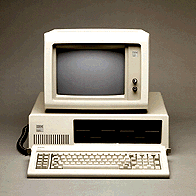Emerging standards: 1980-82
4-frogdesign || 5-Corporate focus || Conclusion || Bibliography & links
![]()
![]()
At the time that the Apple III was failing, Apple's dominance in the growing personal computer industry was facing potential threats from two very different directions. Rumours circulated that the largest of large computer manufacturers, IBM, was about to enter the growing microcomputer industry. Meanwhile, Apple already had increased competition in its home market from less versatile but far less expensive "appliance" computers, specifically those from Commodore.
These very different forms generated very different standards. Each a slab that mediated between the television screen and a joystick, the Commodore computers helped set a general model for home arcade game machines (though their generally underused keyboard would not remain).
Commodore VIC-20 (1980) and 64 (1982)
The popularity of such inexpensive but limited computers was far less significant than the possibility of a technological leap that would make even Apple's products seem toy-like. The rumours of IBM's intention to manufacture microcomputers made it essential for Apple to create a computer that would be taken seriously as a business tool. IBM was synonymous with serious computing and had become a household name despite its well-known products being powerful and impersonal mainframes sold to institutions. With its enormous resources and established corporate presence, IBM had the potential to create a standard for the personal computer that could cut short Apple's growth.
When IBM introduced its first personal computer, simply called PC, in August 1981, Apple was relieved. The confidence that IBM's product was obviously inferior was so great that Apple ran a full page ad in the Wall Street Journal that boldly said, "Welcome, IBM. Seriously." One Apple employee, Chris Espinosa, remembered thinking "at first it was embarrassing how bad their machine was - a half-assed, hackneyed attempt at the old technology. Then we were horrified [at its success]" (Levy, 124-5).
A review in Byte had a more enthusiastic response, praising the PC in a veiled reference to the disappointment of the Apple III: "The genius of the people who designed the IBM microcomputer is that they managed to do everything conventionally but well - the IBM personal computer doesn't have any startling innovations, but it also lacks the moderate-to-fatal design problems that have plagued other microcomputers . . . This microcomputer is as close as I've ever seen to being all things to everybody" (Williams, 70). IBM itself underestimated the response, believing that after an initially larger demand, sales would decline to about 200 000 a year - maintaining a steady level like the sale of their mainframes. As predicted, the millionth sale was reached after three years, but demand continued to increase so that IBM was soon selling over 200 000 personal computers a month (Carroll, 40).
The IBM PC had an immediate identity as a serious machine. In large part, this image stemmed simply from the brand name; IBM gave credibility to the personal computer industry by adding its established corporate presence to companies that had grown from "homebrew" hobbyists. The small square logo on the front of each IBM product brought an association to enormously powerful mainframes. However, the importance of its physical appearance cannot be underestimated.
IBM PC (1981)
Though technologically
conservative, the IBM PC was popular for its open
architecture. A similar approach had benefited the Apple II.
However, IBM did much more than encourage a subindustry
around supplementary boards for expansion slots. Since it
contained no necessary proprietary parts, the IBM could be
"cloned" by other manufacturers. Making very few innovations
allo wed IBM to produce
the PC quickly, taking only about 13 months compared to its
then usual five year period from concept to completed
product (Morgan, 6).
By sanctioning its competitors to copy its design, IBM made
the PC a standard through a joint effort, though this
strategy eventually led to its being surpassed by its
imitators. Clones of the PC, advertised as "IBM-compatible,"
began to appear in 1982, and became common enough to
encroach on IBM's own sales by 1986
(Chposky, 212-3).
These "PCs" almost uniformly followed the cluttered,
industrial appearance that IBM had embraced.
wed IBM to produce
the PC quickly, taking only about 13 months compared to its
then usual five year period from concept to completed
product (Morgan, 6).
By sanctioning its competitors to copy its design, IBM made
the PC a standard through a joint effort, though this
strategy eventually led to its being surpassed by its
imitators. Clones of the PC, advertised as "IBM-compatible,"
began to appear in 1982, and became common enough to
encroach on IBM's own sales by 1986
(Chposky, 212-3).
These "PCs" almost uniformly followed the cluttered,
industrial appearance that IBM had embraced.
Despite the unfriendly, industrial appearance of the PC, IBM marketed its personal computers with a long series of cheerful advertisements suggesting that computers should not intimidate. These ads, featuring a character resembling Charlie Chaplin's Little Tramp, were themselves imitated by clone and component manufacturers. One ad for an IBM-compatible, for example, features a Chaplin figure holding out his empty pockets, while the text says "Paying $4000 for an IBM PC could make a tramp out of anyone" (Sequa Computer Corp. ad in Byte, May 1984, p. 8). Other ads merely allude to IBM's campaign with the presence of the characteristic bowler hat (Titan Technologies Inc. ad in Byte, March 1984, p. 69). The suggestion of IBM's ads, reinforced by the parasitic campaigns, but inevitably belied by products, is that a PC is so user friendly it can be used even by the clown-like tramp.
To the Macintosh
Revolution (1983-85) ![]()
Home || Introduction || Historiography || 1-Cottage industry || 2-Emerging standards || 3-Macintosh
4-frogdesign || 5-Corporate focus || Conclusion || Bibliography & links







.jpg)








